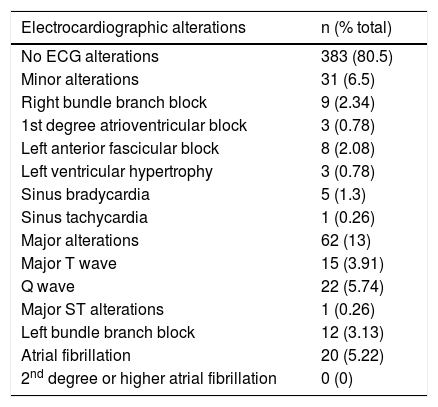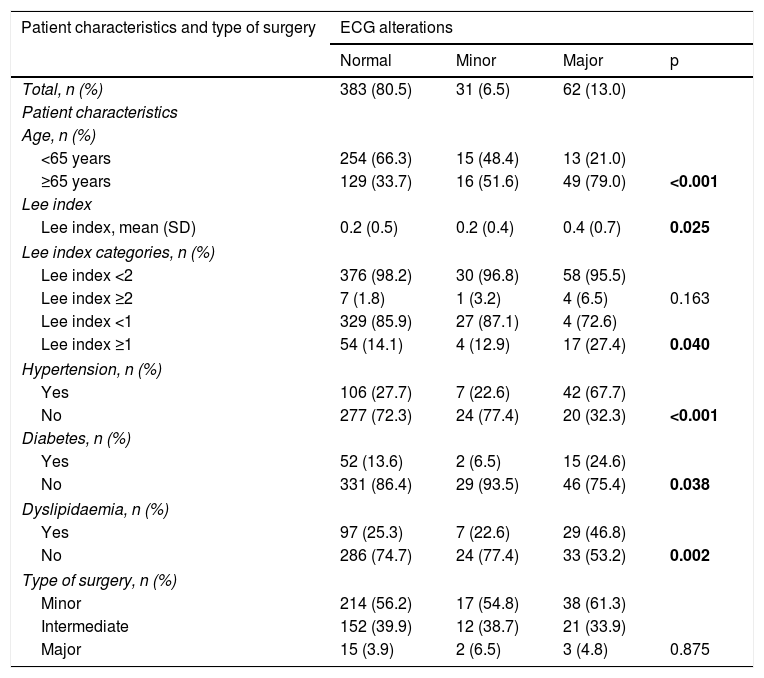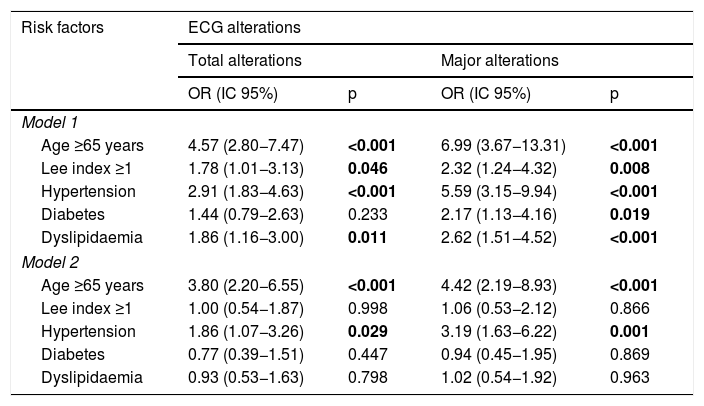The electrocardiogram is the most widely used test to assess cardiovascular risk during the preoperative period.
The objective of the present study is to evaluate the incidence of electrocardiographic alterations in the general population scheduled for non-cardiac surgery and to determine if the age greater than or equal to 65 years or the revised cardiac risk index ≥1 represent a risk factor for presenting these alterations.
Material and methodsOver a period of one month, all preoperative electrocardiograms (ECG) from the anesthesia clinic were analyzed. Various epidemiological data were collected and the revised cardiac risk index was calculated. Major alterations were defined as those requiring Cardiology follow-up.
Results476 patients were recruited, of whom 40.8% were ≥65 years, 32.6% had HTN, 14.4% DM and 27.9% dyslipidemia. 16.16% of the patients had a Lee Index ≥1.
Of the entire sample, 80.5% had a normal ECG, 6.5% minor alterations and 13.0% major alterations. In the multivariate analysis, age ≥65 years and the presence of HTN were shown as independent risk factors for presenting alterations in the total and major ECG.
The Lee index ≥1 was not associated with an increased risk of electrocardiographic abnormalities.
ConclusionsPatients ≥65 years old and those with HTN are at greater risk of presenting major electrocardiographic abnormalities, so we recommend including the ECG as a routine diagnostic test in the preoperative period of non-cardiac surgery.
El electrocardiograma es la prueba más utilizada para evaluar el riesgo cardiovascular durante el periodo preoperatorio.
El objetivo del presente estudio es evaluar la incidencia de alteraciones electrocardiográficas en la población general programada para cirugía no cardiaca y determinar si la edad ≥65 años o el índice de riesgo cardiaco revisado ≥1 suponen un factor de riesgo para presentar dichas alteraciones.
Material y métodosDurante un periodo de un mes se analizaron todos los electrocardiogramas (ECG) preoperatorios de la consulta de anestesia. Se recogieron datos epidemiológicos y se calculó el índice de riesgo cardiaco revisado. Se definieron como alteraciones electrocardiográficas mayores aquellas que precisaban seguimiento por Cardiología.
ResultadosSe reclutaron 476 pacientes, de los cuales 40,8% eran ≥65 años, 32,6% tenían HTA, 14,4% DM y 27,9% dislipemia. Un 16,16% de los pacientes tuvieron un Índice de Lee ≥1.
El 80,5% de los pacientes presentaban un ECG normal, el 6,5% alteraciones menores y el 13%, alteraciones mayores.
En el análisis multivariante, la edad ≥65 años y la presencia de HTA se mostraron como factores de riesgo independiente para presentar alteraciones en el ECG totales y mayores.
El índice de Lee ≥1 no se asoció a un mayor riesgo de alteraciones electrocardiográficas.
ConclusiónLos pacientes ≥65 años o aquellos con HTA tienen mayor riesgo de presentar alteraciones electrocardiográficas mayores, por lo que recomendamos incluir en éstos el ECG como prueba diagnóstica preoperatoria de rutina en cirugía no cardiaca.
Artículo
Comprando el artículo el PDF del mismo podrá ser descargado
Precio 19,34 €
Comprar ahora









